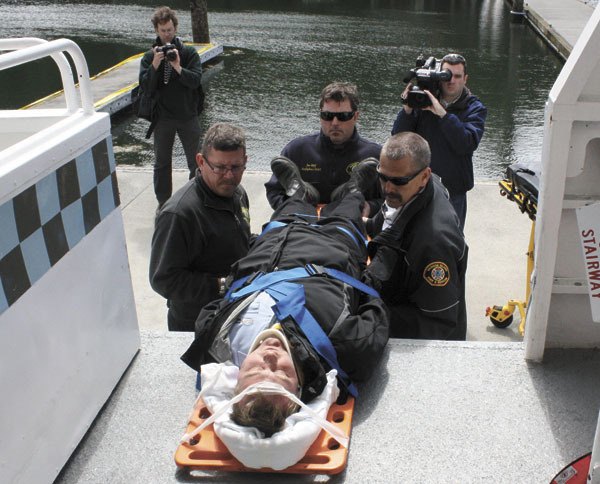Vashon’s emergency preparedness experts learned Wednesday what they weren’t sure of before: Should the ferry system go down in an earthquake, King County’s water taxi could be called into service, picking up critically injured people from key Island locations.
Six counties, including King, held a regional, two-day drill last week to determine the region’s capacity to respond to a major tremor. Called “Evergreen Quake 2012,” the drill was in response to a hypothetical that organizers said would never happen but that gave several jurisdictions a chance to test their emergency response mettle — five near-simultaneous earthquakes along major Puget Sound faults. The drill involved not only the six counties, but the state, 20 cities, several tribes and several private-sector partners.
On Vashon, the drill assumed a shallow 7.1 magnitude quake along the Tacoma Fault, which runs straight across Vashon — an eventuality that Vashon Fire Chief Hank Lipe said would create “a humanitarian crisis” on the Island. In such a scenario, according to Rick Wallace, who served as the head of Vashon’s Emergency Operations Center for the exercise, both ferry docks would sustain major damage, spelling a temporary halt to ferry traffic and leading to a major food and water crisis within four to five days.
So as part of the drill — and in a first for the region’s preparedness community — Vashon and King County partnered on what they called Operation Lifeline, employing the county’s water taxi and privately owned barges in an effort to establish a transportation link between what would become an isolated island and the mainland.
On Wednesday, they played out the scenario: The Melissa Ann, a 77-foot catamaran that normally ferries pedestrians from Vashon to downtown Seattle, nosed up to the Tramp Harbor Pier, closed in on Point Robinson and then docked at the marina at Dockton, where it took on a passenger who was strapped to a backboard.
Wallace called the test a milestone in the region’s preparedness effort.
“For years, we’ve worried about what would happen if the Island were isolated,” he said a few days before the drill. “The huge breakthrough — and what makes this different from Sound Shake 2010 (the last major drill) — is that we’re actually going to do it.”
The goal, he and others said, was to determine whether the Melissa Ann could sidle up to the Tramp Harbor Pier, if it could get close enough to the beach at Point Robinson to take on passengers and how easily it would be to load and off-load at Dockton. At all three locations, officials said, they discovered that the catamaran could provide needed help.
“This is really a success for us. It has put what we had on paper into reality and given everyone a good check,” said Ron Panzero, operations and maintenance manager for the county’s marine division, as he stood on the Dockton pier where the Melissa Ann was moored.
“We drill constantly,” he added. “This for us is one more tool in the toolbox for Vashon Island.”
Dan Krehbiel, captain of the Melissa Ann, said the exercise gave his crew a chance to test their judgment in some new and tricky scenarios. He opted not to make contact at Tramp Harbor because it would have scraped the boat, causing some cosmetic damage. But he determined that the boat could reach the pier in an emergency, he said.
And at Dockton, he said, he found it was possible to dock the boat.
“It’s a small, tender dock and a big, heavy boat,” he said after the Melissa Ann was safely tied to the pier. “It was easy. But you have to be ginger.”
A team that included several firefighters from Vashon Island Fire & Rescue (VIFR) also practiced a scenario, loading a man strapped on to a backboard and into the Melissa Ann. In the process, they found that the gurneys used to transfer an injured person into a vehicle are tall enough to get victims into the Melissa Ann and that the boat could accommodate about 20 gurneys and 30 backboards.
“You never know if it’s going to work,” said Brett Kranjcevich, a volunteer assistant fire chief with VIFR. “These are questions we’ve wanted to answer for quite some time. We did it, and it worked quite well.”
At a debriefing Wednesday afternoon, several key players noted elements of the exercise that were difficult. Because the tide was so low, for instance, the ramp to the pier where the Melissa Ann was moored was dangerously steep, making it hard to get a person on a gurney down the ramp, Mark Nassutti, one of the volunteers, noted.
Others in the extensive drill encountered other difficulties — how to effectively get out public bulletins, for instance, or the lack of timely responses from the county about a pressing issue.
But the group also said their ability to handle curve balls thrown at them was considerably greater this time around, and Wallace and Lipe were pleased by what the marine drill demonstrated.
“It was a historic day,” Lipe said. “The cooperation of the King County Ferry District was huge.”



